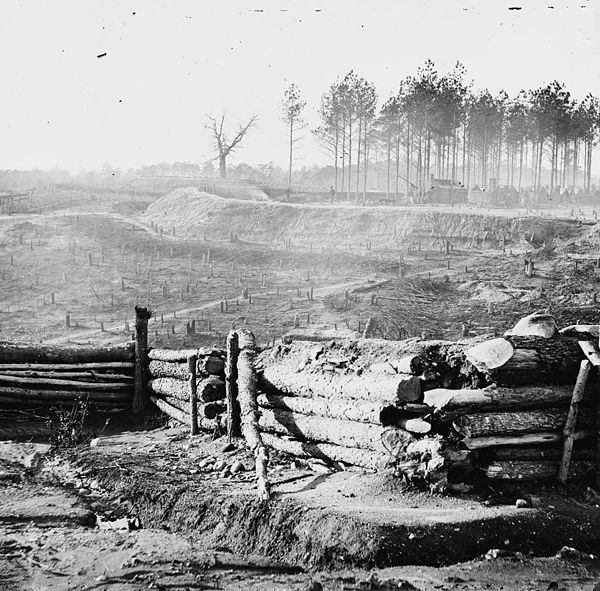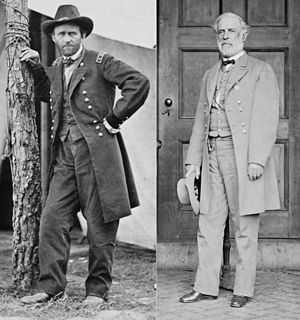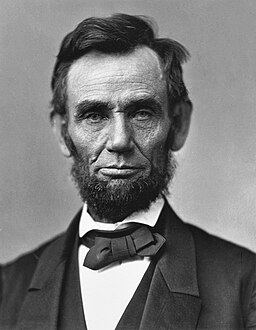
The Richmond–Petersburg Campaign was a series of battles around Petersburg, Virginia, fought from June 15, 1864, to April 2, 1865, during the American Civil War. Although it is more popularly known as the Siege of Petersburg, it was not a classic military siege, in which a city is usually surrounded and all supply lines are cut off, nor was it strictly limited to actions against Petersburg. The campaign consisted of nine months of trench warfare in which Union forces commanded by Lt. Gen. Ulysses S. Grant assaulted Petersburg unsuccessfully and then constructed trench lines that eventually extended over 30 miles (48 km) from the eastern outskirts of Richmond, Virginia, to around the eastern and southern outskirts of Petersburg. Petersburg was crucial to the supply of Confederate Gen. Robert E. Lee's army and the Confederate capital of Richmond. Numerous raids were conducted and battles fought in attempts to cut off the Richmond and Petersburg Railroad. Many of these battles caused the lengthening of the trench lines.

Drewry's Bluff is located in northeastern Chesterfield County, Virginia in the United States. It was the site of Confederate Fort Darling during the American Civil War. It was named for a local landowner, Confederate Captain Augustus H. Drewry.
The Army of the James was a Union Army that was composed of units from the Department of Virginia and North Carolina and served along the James River during the final operations of the American Civil War in Virginia.
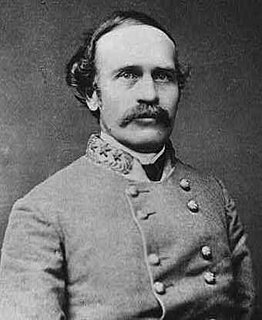
Bushrod Rust Johnson was a Confederate general in the American Civil War and an officer in the United States Army. As a university professor he had been active in the state militias of Kentucky and Tennessee and on the outbreak of hostilities he sided with the South, despite having been born in the North. As a divisional commander he managed to evade capture at the Battle of Fort Donelson, but was wounded at the Battle of Shiloh. He served under Robert E. Lee throughout the 10-month Siege of Petersburg, and surrendered with him at Appomattox.
The Valley Campaigns of 1864 were American Civil War operations and battles that took place in the Shenandoah Valley of Virginia from May to October 1864. While some military historians divide this period into three separate campaigns, they interacted in several ways, so this article considers all three together.

XVIII Corps was a North Carolina corps of the Union Army during the American Civil War.
XXIV Corps was a corps of the Union Army during the American Civil War.

The Second Battle of Petersburg, also known as the Assault on Petersburg, was fought June 15–18, 1864, at the beginning of the Richmond–Petersburg Campaign. Union forces under Lt. Gen. Ulysses S. Grant attempted to capture Petersburg, Virginia, before Gen. Robert E. Lee's Confederate Army of Northern Virginia could reinforce the city.
The First Battle of Petersburg was an unsuccessful Union assault against the earthworks fortifications—the Dimmock Line—protecting the city of Petersburg, Virginia, June 15, 1864, during the American Civil War. Because of the rag-tag group of defenders involved, it is sometimes known as the Battle of Old Men and Young Boys.
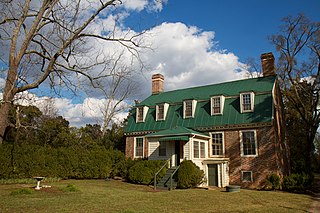
The Battle of Totopotomoy Creek, also called the Battle of Bethesda Church, Crumps Creek, Shady Grove Road, and Hanovertown, was a battle fought in Hanover County, Virginia in May 28–30, 1864, as part of Union Lt. Gen. Ulysses Grant's Overland Campaign against Confederate Gen. Robert E. Lee's Army of Northern Virginia.
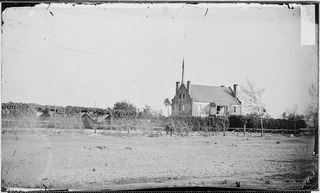
The Battle of Globe Tavern, also known as the Second Battle of the Weldon Railroad, fought August 18–21, 1864, south of Petersburg, Virginia, was the second attempt of the Union Army to sever the Weldon Railroad during the Siege of Petersburg of the American Civil War. A Union force under Maj. Gen. Gouverneur K. Warren destroyed miles of track and withstood strong attacks from Confederate troops under Gen. P.G.T. Beauregard and Lt. Gen. A.P. Hill. It was the first Union victory in the Richmond-Petersburg Campaign. It forced the Confederates to carry their supplies 30 miles (48 km) by wagon to bypass the new Union lines that were extended farther to the south and west.
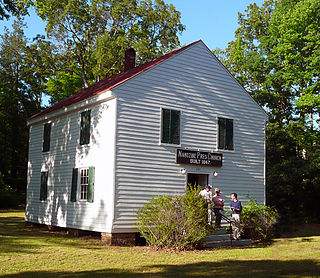
The Battle of Namozine Church, Virginia was an engagement between Union Army and Confederate States Army forces that occurred on April 3, 1865 during the Appomattox Campaign of the American Civil War. The battle was the first engagement between units of General Robert E. Lee's Confederate Army of Northern Virginia after that army's evacuation of Petersburg and Richmond, Virginia on April 2, 1865 and units of the Union Army under the immediate command of Maj. Gen. Philip Sheridan, who was still acting independently as commander of the Army of the Shenandoah, and under the overall direction of Union General-in-Chief Lt. Gen. Ulysses S. Grant. The forces immediately engaged in the battle were brigades of the cavalry division of Union Brig. Gen. and Brevet Maj. Gen. George Armstrong Custer, especially the brigade of Colonel and Brevet Brig. Gen. William Wells, and the Confederate rear guard cavalry brigades of Brig. Gen. William P. Roberts and Brig. Gen. Rufus Barringer and later in the engagement, Confederate infantry from the division of Maj. Gen. Bushrod Johnson.

The Richmond National Battlefield Park commemorates 13 American Civil War sites around Richmond, Virginia, which served as the capital of the Confederate States of America for most of the war. The park connects certain features within the city with defensive fortifications and battle sites around it.

The Battle of Port Walthall Junction was fought May 6–7, 1864, between Union and Confederate forces during the Bermuda Hundred Campaign of the American Civil War. Although initially successful, the Confederates were eventually defeated, allowing Union forces to cut a railroad. The Port Walthall Junction on the Richmond-Petersburg Railroad connected with the spur to Port Walthall.
The Battle of Chester Station was fought on May 10, 1864, between Union and Confederate forces during the American Civil War. The Confederates attacked portions of Benjamin Butler's Union forces.
The Battle of Proctor's Creek, also known as Drewry's Bluff or Fort Darling, was fought May 12–16, 1864, in Chesterfield County, Virginia, during the Bermuda Hundred Campaign of the American Civil War. Proctor's Creek was named for Charles Proctor, who lived and farmed on the land surrounding most of the creek.

The Eastern Theater of the American Civil War consists of the major military and naval operations in the states of Virginia, West Virginia, Maryland, and Pennsylvania, the District of Columbia, and the coastal fortifications and seaports of North Carolina.
The Battle of Amelia Springs, Virginia was an engagement between the Union Army and Confederate Army of Northern Virginia that occurred on April 5, 1865 during the Appomattox Campaign of the American Civil War. It was followed by a second rear guard action near the same location on the night of April 5, 1865 and morning of April 6, 1865 during the Union Army pursuit of the Confederate forces which were fleeing westward after the fall of Petersburg and Richmond, Virginia at the Third Battle of Petersburg on April 2, 1865. The actions took place just prior to the Battle of Sailor's Creek on April 6, 1865. That battle would be the last major engagement between the Union Army under the overall direction of Union General-in-Chief, Lt. Gen. Ulysses S. Grant, and General Robert E. Lee's Army of Northern Virginia before that Confederate army's surrender at Appomattox Court House, Virginia on April 9, 1865.

The First Battle of Deep Bottom, also known as Darbytown, Strawberry Plains, New Market Road, or Gravel Hill, was fought July 27–29, 1864, at Deep Bottom in Henrico County, Virginia, as part of the Siege of Petersburg of the American Civil War. A Union force under Maj. Gens. Winfield S. Hancock and Philip H. Sheridan was sent on an expedition threatening Richmond, Virginia, and its railroads, intending to attract Confederate troops away from the Petersburg defensive line, in anticipation of the upcoming Battle of the Crater. The Union infantry and cavalry force was unable to break through the Confederate fortifications at Bailey's Creek and Fussell's Mill and was withdrawn, but it achieved its desired effect of momentarily reducing Confederate strength at Petersburg.

The Howlett Line was a critical Confederate earthworks dug during the Bermuda Hundred Campaign of the United States Civil War in May 1864. Specifically, the line stretched across the Bermuda Hundred peninsula from the James River to the Appomattox River. It was named for the Dr. Howlett's House that overlooked the James River at the north end of the line. The Howlett Line became famous as the "Cork in the Bottle" by keeping the 30,000-man strong General Butler's Army of the James at bay.
